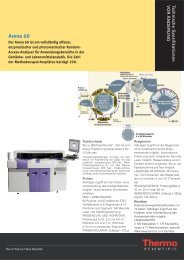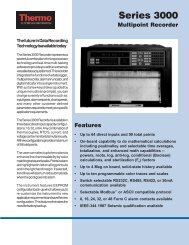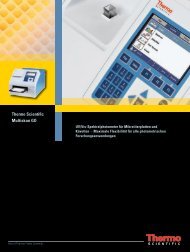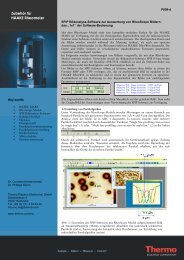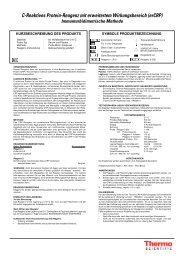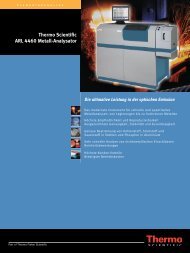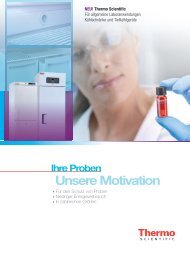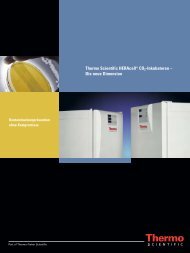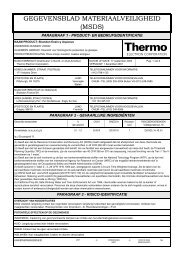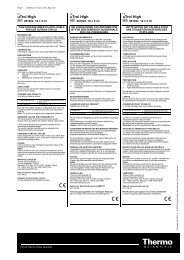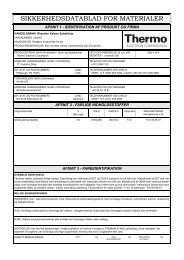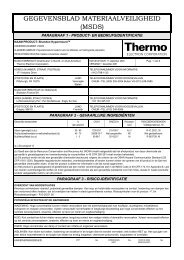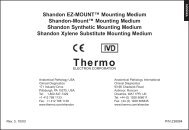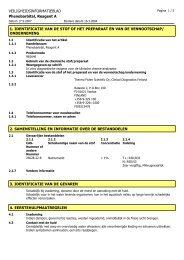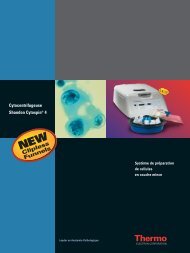A Complete Forensic Toxicology Screening ... - Thermo Scientific
A Complete Forensic Toxicology Screening ... - Thermo Scientific
A Complete Forensic Toxicology Screening ... - Thermo Scientific
You also want an ePaper? Increase the reach of your titles
YUMPU automatically turns print PDFs into web optimized ePapers that Google loves.
Application<br />
Note: 449<br />
Key Words<br />
ToxSpec<br />
Analyzer<br />
ToxID Software<br />
LXQ Linear Ion<br />
Trap<br />
Clinical<br />
<strong>Toxicology</strong><br />
General<br />
Unknown<br />
<strong>Screening</strong><br />
A <strong>Complete</strong> <strong>Forensic</strong> <strong>Toxicology</strong> <strong>Screening</strong><br />
Procedure for Drugs and Toxic Compounds in<br />
Urine and Plasma Using LC-MS/MS<br />
Marta Kozak, Taha Rezai, <strong>Thermo</strong> Fisher <strong>Scientific</strong>, San Jose, CA<br />
Introduction<br />
<strong>Forensic</strong> toxicology laboratories commonly use automated<br />
immunoassays, gas chromatography-mass spectrometry<br />
(GC-MS) and high pressure liquid chromatography-diode<br />
array detector (HPLC-DAD) techniques to perform<br />
toxicology screening analyses. None of these techniques<br />
are able to identify all the drugs and toxic compounds<br />
that are potentially present in a sample. Implementation of<br />
liquid chromatography-mass spectrometry (LC-MS) for<br />
forensic toxicology screening provides specific and<br />
sensitive analysis of drugs and toxic substances. The<br />
benefits of the LC-MS/MS screening methodology include<br />
a simple sample preparation procedure, ease of adding<br />
new compounds to the screening method and fewer<br />
limitations based on compound volatility and thermal<br />
stability. In addition, <strong>Thermo</strong> <strong>Scientific</strong> ToxID automated<br />
toxicology screening software is able to automatically<br />
generate both Summary and Long Reports, avoiding the<br />
need for manual analysis of each sample chromatogram.<br />
This application note describes the use of the <strong>Thermo</strong><br />
<strong>Scientific</strong> LXQ ion trap mass spectrometer equipped with<br />
an ESI source and HPLC for identification of unknown<br />
compounds in urine and plasma for clinical research and<br />
forensics.<br />
Goal<br />
To develop a complete LC-MS/MS forensic screening<br />
methodology which includes a sample preparation<br />
method, LC-MS method, spectra library, and data<br />
processing and reporting software.<br />
Experimental Conditions<br />
An MS/MS spectral library of 275 drugs and toxic<br />
compounds was created. Sample preparation of spiked<br />
human urine or human plasma was carried out using a<br />
solid-phase extraction (SPE) cartridge for basic, neutral<br />
and acidic compounds. A 13-minute LC method<br />
implementing a Perfluorophenyl (PFP) column was<br />
developed. Samples were analyzed using electrospray<br />
ionization (ESI) on an ion trap mass spectrometer in<br />
polarity switching scan dependent MS/MS experiments<br />
(see Figure 1), with retention time windows specified for<br />
each listed parent mass. The method allows acquisition of<br />
MS2 spectra for co-eluting compounds and analysis of<br />
positively and negatively ionized compounds with a single<br />
run. Figure 2 shows the overall application workflow.<br />
Scan Event 1<br />
+ Full Scan MS<br />
Scan Event 2-6<br />
+ MS/MS on parent list<br />
Figure 1: MS scan events<br />
Step 1: Extract analytes from urine<br />
or plasma with SPE procedure<br />
Step 2: Analyze the samples<br />
with LC-MS/MS method<br />
Step 3: Automated library search and<br />
reporting with software<br />
Figure 2: Step-by-step application workflow<br />
Scan Event 7<br />
– Full Scan MS<br />
Scan Event 8-9<br />
– MS/MS on parent list<br />
Sample Preparation<br />
Samples (1 mL of urine or 0.5 mL of plasma) were spiked<br />
with 0.1 mL of an internal standard solution at a<br />
concentration of 1 µg/mL (Chlorpromazine-D3,<br />
Haloperidol-D4 and Prazepam-D5) and diluted with 2 mL<br />
of 0.1 M phosphate buffer pH 6.0. The resulting mix was<br />
extracted with an SPE (<strong>Thermo</strong> <strong>Scientific</strong> Hypersep Verify-<br />
CX 200 mg mixed mode cartridges) procedure prior to<br />
injection onto LC-MS.
Chromatography<br />
HPLC separation was performed with a <strong>Thermo</strong> <strong>Scientific</strong><br />
Accela pump using a <strong>Thermo</strong> <strong>Scientific</strong> Hypersil GOLD<br />
PFP column (50 x 2.1 mm; 5 µm particles). Flow rate was<br />
set to 200 µL/min. The gradient is summarized in Table 1<br />
(solvent A = water/0.1% formic acid/10 mM ammonium<br />
formate, solvent B = acteonitrile/0.1% formic acid).<br />
Injection volume was 10 µL.<br />
Table 1. Thirteen-minute LC method<br />
Time (minutes) %A %B<br />
0 95 5<br />
0.5 95 5<br />
5.5 5 95<br />
8.5 5 95<br />
8.6 5 95<br />
13 95 5<br />
MS Conditions<br />
Instrument: LXQ ion trap mass spectrometer<br />
Ionization: ESI, <strong>Thermo</strong> <strong>Scientific</strong> Ion Max source<br />
Capillary temperature: 275 ˚C<br />
Spray voltage: 5.0 kV<br />
Sheath gas: 30<br />
Aux gas: 8<br />
Data acquisition mode: Polarity switching scan dependent experiment<br />
Microscans: 1<br />
WideBand Activation :<br />
Stepped Normalized<br />
On<br />
Collision Energy: 35% ± 10%<br />
Method Validation and Results:<br />
The method was prequalified by processing and analyzing<br />
urine samples spiked with 10 randomly selected<br />
compounds in concentrations of 10 ng/mL, 100 ng/mL<br />
and 1000 ng/mL. Table 2 lists the concentration at which<br />
each analyte in the toxicology screen for urine samples is<br />
identified. The presence of an analyte at 10, 100 or 1000<br />
ng/mL implies that the limit of detection is likely below<br />
that value. Of the 275 compounds analyzed, 70% were<br />
detected at 10 ng/mL, 20% at 100 ng/mL, 8% at 1000<br />
ng/mL and 2% were detected at a concentration above<br />
1000 ng/mL.<br />
Table 2. Results for spiked urine samples in toxicology screen by LC-MS/MS<br />
LXQ – 13 min method Concentration Tested (ng/mL)<br />
Compound 10 100 1000<br />
All barbiturates require an APCI source for detection. P=Drug present. N=Drug not present.<br />
11-Hydroxy-delta-9-THC N N >1000<br />
11-nor-9-carboxy-Delta-9-THC N N P<br />
2-Bromo-Alpha-Ergocryptine P P P<br />
2-Hydroxyethylflunitrazepam N P P<br />
3-Hydroxystanozolol N N >1000<br />
4-Hydroxynordiazepam N P P<br />
6-Acetylcodeine P P P<br />
6-Acetylmorphine (6-MAM) P P P<br />
7-Amino-Clonazepam P P P<br />
7-Amino-Flunitrozepam P P P<br />
Acebutolol P P P<br />
a-Hydroxy-Alprazolam P P P<br />
a-Hydroxy-Triazolam P P P<br />
Albuterol P P P<br />
alpha-Hydroxymidazolam N P P<br />
Alprazolam P P P<br />
Alprenolol P P P<br />
Aminorex N P P<br />
Amiodarone P P P<br />
Amitriptyline P P P<br />
Amlodipine N N P<br />
Amobarbital P P P<br />
Amoxapine P P P<br />
Amphetamine P P P<br />
Anhydroecgonine MethylEster N P P<br />
Antipyrine N N >1000<br />
Apomorphine N N >1000
LXQ – 13 min method Concentration Tested (ng/mL)<br />
Compound 10 100 1000<br />
Astemizole N P P<br />
Atenolol P P P<br />
Atropine N P P<br />
BDB N P P<br />
Benzocaine N N P<br />
Benzoylecgonine N P P<br />
Betaxolol P P P<br />
Bisacodyl P P P<br />
Bisoprolol P P P<br />
Bromazepam P P P<br />
Brompheniramine P P P<br />
Bupivocaine P P P<br />
Buprenorphine P P P<br />
Bupropion P P P<br />
Buspirone P P P<br />
Butalbital N P P<br />
Butorphanol P P P<br />
Cannabidiol N N >1000<br />
Cannabinol N N >1000<br />
Captopril N N P<br />
Carbamazepine P P P<br />
Carbinoxamine N P P<br />
Carisoprodol N N P<br />
Cathinone N N P<br />
Chlordiazepoxide P P P<br />
Chlorothiazide N P P<br />
Chlorpheniramine P P P<br />
Chlorpromazine P P P<br />
Chlorpromazine-D3 N P P<br />
Chlorprothixene N N >1000<br />
Cinnarizine P P P<br />
cis-4-Methylaminorex N P P<br />
Cisapride N P P<br />
Citalopram P P P<br />
Clenbuterol P P P<br />
Clenbuterol N P P<br />
Clobazam N P P<br />
Clomipramine P P P<br />
Clonazepam P P P<br />
Clonidine P P P<br />
Clopidogrel P P P<br />
Clozapine P P P<br />
Cocaethylene P P P<br />
Cocaine P P P<br />
Codeine P P P<br />
Cyclobenzaprine P P P<br />
Delta9-THC N P P<br />
Desalkylflurazepam N P P<br />
Desipramine N P P<br />
Desmethyldoxepin P P P<br />
Dextromethorphan P P P<br />
Diazepam P P P<br />
Diflunisal P P P<br />
Digoxin N N P<br />
Dihydrocodeine P P P<br />
Dihydroergotamine P P P<br />
Diltiazem P P P<br />
Diphenhydramine P P P<br />
Dipyridamole N N P<br />
Disopyramide P P P<br />
Dothiepin N P P<br />
Doxepin P P P<br />
Doxylamine P P P<br />
Ecgonine-Methyl-Ester N N P<br />
EDDP P P P<br />
EMDP P P P<br />
Enalapril P P P<br />
Ephedrine N P P
LXQ – 13 min method Concentration Tested (ng/mL)<br />
Compound 10 100 1000<br />
Ergotamine P P P<br />
Estazolam N P P<br />
Felcainide P P P<br />
Fendiline P P P<br />
Fenfluramine P P P<br />
Fentanyl P P P<br />
Fexofenadine P P P<br />
Flumethasone N N P<br />
Flunitrazepam P P P<br />
Flunixin N P P<br />
Fluoxetine P P P<br />
Fluoxymesterone N P P<br />
Fluphenazine P P P<br />
Flurazepam P P P<br />
Fluvoxamine P P P<br />
Furosemide N P P<br />
Gabapentin N N P<br />
Gliclazide N N P<br />
Glimepiride N P P<br />
Glipizide P P P<br />
Glyburide P P P<br />
Haloperidol P P P<br />
Haloperidol-D4 N P P<br />
Heroin P P P<br />
HMMA N N >1000<br />
Hydrochlorothiazide N N P<br />
Hydrocodone P P P<br />
Hydromorphone P P P<br />
Hydroxyzine N P P<br />
Imipramine P P P<br />
Indomethacin N N >1000<br />
Isradipine P P P<br />
Ketamine P P P<br />
Ketoconazole P P P<br />
Ketoprofen N N >1000<br />
Ketorolac N N >1000<br />
Labetolol N P P<br />
Lamotrigine P P P<br />
LAMPA P P P<br />
Lidocaine P P P<br />
Lometazepam N P P<br />
Loratadine P P P<br />
Lorazepam P P P<br />
LSD P P P<br />
Maprotiline P P P<br />
MBDB N P P<br />
MDA P P P<br />
MDEA N P P<br />
MDMA P P P<br />
Melatonin N N >1000<br />
Meperidine P P P<br />
Mepivocaine N P P<br />
Meprobamate N P P<br />
Mescaline P P P<br />
Mesoridazine P P P<br />
Metaprolol P P P<br />
Methadienone P P P<br />
Methadone P P P<br />
Methamphetamine P P P<br />
Methaqualone N N >1000<br />
Methcathinone N N P<br />
Methenolone P P P<br />
Methohexital P P P<br />
Methoxyverapmil P P P<br />
Methylphenidate P P P<br />
Metoclopramide P P P<br />
Metronidazole N P P<br />
Mexiletine N N >1000<br />
LXQ – 13 min method<br />
Compound<br />
Mianserin<br />
Miconazole<br />
Midazolam<br />
Mirtazapine<br />
Molsidomine<br />
Morphine<br />
Morphine-3-b-glucuronide<br />
Nalbuphine<br />
Nalorphine<br />
Naloxone<br />
Naltrexone<br />
NAPA<br />
N-DemethylTrimipramine<br />
N-Desmethyl-cis-tramadol<br />
N-Desmethylflunitrazepam<br />
N-Desmethylselegiline<br />
N-DesmthylClomipramine<br />
N-Ethylamphetamine<br />
Nicardipine<br />
Nicotine<br />
Nitrazepam<br />
Nitrendipine<br />
Nizatidine<br />
Norbenzoylecgonine<br />
Norbuprenorphine<br />
Norclomipramine<br />
Norcocaethylene<br />
Norcocaine<br />
Norcodeine<br />
Nordiazepam<br />
Nordoxepin<br />
Norethandrolone<br />
Norfentanyl<br />
Norfluoxetine<br />
Norketamine<br />
NOR-LSD<br />
Normeperidine<br />
Normorphine<br />
Noroxycodone<br />
Noroxymorphone<br />
Norproproxyphene<br />
Nortriptyline<br />
Noscapine<br />
OH-LSD<br />
Ondansetron<br />
Opipramol<br />
Oxazepam<br />
Oxcarbazepine<br />
Oxycodone<br />
Oxymorphone<br />
Papaverine<br />
Paraxanthine<br />
Paroxetine<br />
PCP<br />
Pentazocine<br />
Pentobarbital<br />
Perphenazine<br />
Pheniramine<br />
Phenobarbital<br />
Phenolphthalein<br />
Phentermine<br />
Phenylbutazone<br />
Phenyltoloxamine<br />
Physostigmine<br />
Pindolol<br />
Piroxicam<br />
PMA<br />
PMMA
Concentration Tested (ng/mL)<br />
10 100 1000<br />
P P P<br />
P P P<br />
P P P<br />
P P P<br />
N N >1000<br />
N P P<br />
N N >1000<br />
P P P<br />
P P P<br />
P P P<br />
P P P<br />
P P P<br />
P P P<br />
N N P<br />
N P P<br />
N P P<br />
N P P<br />
N P P<br />
P P P<br />
P P P<br />
N N >1000<br />
P P P<br />
N N P<br />
N N >1000<br />
N N >1000<br />
P P P<br />
P P P<br />
P P P<br />
N P P<br />
P P P<br />
P P P<br />
N P P<br />
N P P<br />
P P P<br />
N P P<br />
P P P<br />
P P P<br />
N N P<br />
N P P<br />
N N >1000<br />
P P P<br />
P P P<br />
P P P<br />
N P P<br />
P P P<br />
P P P<br />
P P P<br />
N N P<br />
P P P<br />
N P P<br />
P P P<br />
N N >1000<br />
N P P<br />
P P P<br />
P P P<br />
P P P<br />
P P P<br />
N P P<br />
P P P<br />
P P P<br />
N N P<br />
N N P<br />
N N P<br />
P P P<br />
N N P<br />
P P P<br />
N N P<br />
N P P<br />
LXQ – 13 min method Concentration Tested (ng/mL)<br />
Compound 10 100 1000<br />
Prazepam-D5 N P P<br />
Prazosin P P P<br />
Prilocaine N N P<br />
Procainamide N P P<br />
Promazine P P P<br />
Promethazine N P P<br />
Prometryn N P P<br />
Propafenone P P P<br />
Propoxyphene P P P<br />
Propranolol P P P<br />
Protriptyline P P P<br />
Psilocin N P P<br />
Pyrilamine P P P<br />
Quetiapine P P P<br />
Quinidine P P P<br />
Quinine N P P<br />
Ranitidine N N P<br />
Risperidone P P P<br />
Scopolamine P P P<br />
Secobarbital P P P<br />
Selegiline N P P<br />
Sertraline P P P<br />
Sotalol N P P<br />
Spironolactone N P P<br />
Stanozolol N P P<br />
Telmisartan P P P<br />
Temazepam P P P<br />
Terfenadine P P P<br />
Tetracine P P P<br />
Thiamylal N P P<br />
Thiopental P P P<br />
Thioridazine P P P<br />
Thiothixene P P P<br />
Timolol P P P<br />
Topiramate P P P<br />
Trazodone P P P<br />
Triazolam P P P<br />
Trimethoprim P P P<br />
Trimipramine P P P<br />
Venlafaxine P P P<br />
Verapamil P P P<br />
Vincristine P P P<br />
Warfarin P P P<br />
Zimelidine P P P<br />
Zolpidem P P P<br />
Zopiclone N N P<br />
All barbiturates require an APCI source for detection. P=Drug present. N=Drug not present.
Table 3. Results for spiked plasma samples in toxicology screen by LC-MS/MS<br />
LXQ – 13 min method Concentration Tested (ng/mL)<br />
Compound 10 100 1000<br />
BDB N P P<br />
Benzocaine N P P<br />
Benzoylecgonine P P P<br />
Betaxolol P P P<br />
Bisacodyl P P P<br />
Bisoprolol P P P<br />
Bromazepam N P P<br />
Brompheniramine N P P<br />
Bufotenine N P P<br />
Bupivocaine P P P<br />
Buprenorphine P P P<br />
Bupropion N P P<br />
Buspirone P P P<br />
Butorphanol P P P<br />
Cannabidol N P P<br />
Cannabinol N P P<br />
Captopril N N >1000<br />
Estazolam N P P<br />
Carbamazepine P P P<br />
Carbinoxamine P P P<br />
Carisoprodol N P P<br />
Cathinone N N >1000<br />
Chlordiazepoxide N P P<br />
Chloroquine N P P<br />
Chlorpheniramine P P P<br />
Chlorpromazine N P P<br />
Chlorprotixene P P P<br />
Clozapine N-Oxide N P P<br />
All barbiturates require an APCI source for detection. P=Drug present. N=Drug not present.<br />
For selected sets of compounds the method was also<br />
prequalified by processing and analyzing spiked plasma<br />
samples. Table 3 lists the concentration at which each<br />
analyte in the toxicology screen for plasma samples is<br />
identified. In general, detection limits for urine and plasma<br />
are comparable.<br />
In addition, the assay performance was verified by<br />
analyzing urine samples and data were compared to the<br />
results from established LC-UV and immunoassay<br />
analytical techniques. The result is shown in Table 4. The<br />
LC-MS/MS method has consistently identified more<br />
analytes present in the sample than either LC-UV or<br />
immunoassays.<br />
Table 4. Urine sample analyzed with LC-MS/MS, LC-UV and Immunoassay methods<br />
LC-MS LC-UV Immunoassay<br />
Nortriptyline Nortriptyline Barbiturates<br />
Amitriptyline Amitriptyline Benzodiazepines<br />
Benzoylecgonine Benzoylecgonine Cocaine<br />
Cocaine Cocaine Opiates<br />
Norcocaethylene Cocaethylene THC<br />
Norbenzoylecgonine - -<br />
Morphine - -<br />
Norcocaine - -<br />
Raw File Name: C:\Documents and S<br />
Config File Name: C:\Xcalibur\exam<br />
Sample Name:<br />
Laboratory: ChemLab<br />
Acquistion Start Time: 2/13/2007 1:0<br />
Peak 1<br />
Peak 2<br />
Peak 3<br />
Peak 4<br />
Peak 5<br />
Peak 6<br />
Peak 7<br />
Peak 8<br />
100<br />
50<br />
0<br />
100<br />
50<br />
0<br />
100<br />
50<br />
0<br />
100<br />
50<br />
0<br />
100<br />
50<br />
0<br />
100<br />
50<br />
0<br />
100<br />
50<br />
0<br />
100<br />
50<br />
0<br />
2<br />
2.42<br />
2.9<br />
Peak Compound Name C<br />
Number<br />
1 Bupropion<br />
2 EDDP<br />
3 Venlafaxine<br />
4 Methadone<br />
5 Chlorpromazine-D3<br />
6 Prazepam-D5<br />
7 Haloperidol-D4<br />
8 Quetiapine<br />
Figure 3: The ToxID Summary Re
Company Name<br />
ToxID Summary Report<br />
ettings\marta.kozak\Desktop\Desktop\Application_Notes\ToxID\2J.RAW<br />
ples\ToxID\ToxID_config_13min.csv<br />
4:54 AM<br />
5.06<br />
5.12<br />
5.18 5.91<br />
6.76<br />
6.82<br />
6.69 6.86<br />
3.93 5.13 6.63 6.96 7.55<br />
4.83<br />
4.89<br />
7<br />
4.78 4.95 6.86 7.61<br />
6.83<br />
6.87<br />
6.71 6.91<br />
7.35<br />
6.82 6.82<br />
6.76 6.90<br />
6.70 7.01<br />
7.51<br />
5.56<br />
5.61<br />
5.18 5.68 6.97<br />
6.20<br />
6.26<br />
6.32<br />
6.16<br />
6.38<br />
7.18<br />
5.45<br />
5.40<br />
5.51<br />
6.28<br />
4 6 8 10 12<br />
Time (min)<br />
ode SI RSI m/z Expected<br />
RT<br />
Page 1 of 1<br />
NL: 1.49E5<br />
m/z= 183.8-184.2 F: ITMS + c ESI<br />
d w Full ms2 240.00@cid35.00<br />
[55.00-250.00]<br />
NL: 9.55E3<br />
m/z= 249.0-249.4 F: ITMS + c ESI<br />
d w Full ms2 278.25@cid35.00<br />
[65.00-290.00]<br />
NL: 1.30E4<br />
m/z= 215.0-215.4 F: ITMS + c ESI<br />
d w Full ms2 278.25@cid35.00<br />
[65.00-290.00]<br />
NL: 4.23E4<br />
m/z= 264.9-265.3 F: ITMS + c ESI<br />
d w Full ms2 310.15@cid35.00<br />
[75.00-325.00]<br />
NL: 2.92E3<br />
m/z= 273.9-274.3 F: ITMS + c ESI<br />
d w Full ms2 322.20@cid35.00<br />
[75.00-335.00]<br />
NL: 1.55E5<br />
m/z= 276.0-276.4 F: ITMS + c ESI<br />
d w Full ms2 330.20@cid35.00<br />
[80.00-345.00]<br />
NL: 8.56E4<br />
m/z= 168.9-169.3 F: ITMS + c ESI<br />
d w Full ms2 380.40@cid35.00<br />
[90.00-395.00]<br />
NL: 3.95E4<br />
m/z= 253.0-253.4 F: ITMS + c ESI<br />
d w Full ms2 384.25@cid35.00<br />
[95.00-395.00]<br />
Real RT Intensity Library Name<br />
p 909 909 240.0 5.20 5.06 148721 Tox_Library<br />
p 857 873 278.2 6.60 6.76 9549 Tox_Library<br />
p 816 837 278.2 4.90 4.83 12964 Tox_Library<br />
p 932 932 310.2 6.70 6.83 42262 Tox_Library<br />
i 859 859 322.2 6.80 6.82 2924 Tox_Library<br />
i 969 974 330.2 5.60 5.56 154827 Tox_Library<br />
i 830 837 380.4 6.20 6.26 85589 Tox_Library<br />
p 870 871 384.2 5.40 5.45 39512 Tox_Library<br />
port is designed for a quick synopsis of the data.<br />
Table 5. Simple workflow for adding new analytes<br />
Company Name ToxID Long Report<br />
Raw File Name: C:\Documents and Settings\marta.kozak\Desktop\Desktop\Application_Notes\ToxID\2J.RAW<br />
Config File Name: C:\Xcalibur\examples\ToxID\ToxID_config_13min.csv<br />
Sample Name:<br />
Laboratory: ChemLab<br />
Acquistion Start Time: 2/13/2007 1:04:54 AM<br />
Peak<br />
Number<br />
Compound Name Code SI RSI m/z Expected<br />
RT<br />
Page 3 of 8<br />
Real RT Intensity Library Name<br />
3 Venlafaxine p 816 837 278.2 4.90 4.83 12964 Tox_Library<br />
Peak 3<br />
Relative Abundance<br />
100<br />
80<br />
60<br />
40<br />
20<br />
0<br />
Acquired Spectrum<br />
Relative Abundance<br />
100<br />
90<br />
80<br />
70<br />
60<br />
50<br />
40<br />
30<br />
20<br />
10<br />
0<br />
Library Spectrum<br />
Relative Abundance<br />
100<br />
90<br />
80<br />
70<br />
60<br />
50<br />
40<br />
30<br />
20<br />
10<br />
0<br />
2.97 3.22<br />
4.83<br />
4.89<br />
4.78<br />
4.95<br />
5.13 6.15 6.86 7.61<br />
1 2 3 4 5 6 7 8 9 10 11 12 13<br />
Time (min)<br />
121<br />
215<br />
147<br />
86<br />
159<br />
100 135 173 243<br />
100 150 200 250<br />
m/z<br />
121<br />
147<br />
215<br />
159 217<br />
178 233<br />
100 150 200 250<br />
m/z<br />
STEP 1: Directly infuse analyte to obtain MS 2 spectra, then add spectra to the library 10 Minutes<br />
STEP 2: Run analyte on column to obtain retention times 13 Minutes<br />
STEP 3: Update Parent Mass Table in instrument method with parent masses and retention times 2 Minutes<br />
STEP 4: Update ToxID with name, parent masses, the most intense product ion and retention times 2 Minutes<br />
91<br />
Delta Spectrum<br />
Relative Abundance<br />
100<br />
0<br />
-100<br />
Raw data - Library entry<br />
121<br />
86 152 205 243<br />
Library Structure<br />
100 150 200 250<br />
m/z<br />
Figure 4: The ToxID Long Report is designed for a more thorough examination of<br />
the data.<br />
NL: 1.30E4<br />
m/z= 215.0-215.4<br />
F: ITMS + c ESI d w<br />
Full ms2<br />
278.25@cid35.00<br />
[65.00-290.00]<br />
290
ToxID Software Automates Reporting, Reduces<br />
Manual Analysis<br />
ToxID software identifies compounds present in the<br />
sample based on MS/MS spectra and retention times.<br />
Positive hits are automatically reported via ToxID<br />
software. Reports are automatically generated, reducing<br />
the time necessary for manual analysis of each sample<br />
chromatogram. An example of a Summary Report is<br />
shown in Figure 3. A Long Report with one page per<br />
detected compound is shown in Figure 4.<br />
Adding New Compounds to the Application<br />
This LC-MS/MS workflow allows the user to quickly and<br />
easily add new analytes to the screening method. This<br />
feature is very important for forensic toxicology screening<br />
because new target compounds are continually being<br />
added to the target list. As shown in Table 5, new<br />
compounds can typically be added in less than 1 hour.<br />
Conclusion<br />
The comprehensive, turn-key forensic toxicology screening<br />
methodology described in this application note utilizes an<br />
LXQ ion trap, and includes an SPE procedure and LC<br />
method that enables the identification of 275 compounds<br />
in human urine and human plasma. Accompanying ToxID<br />
software performs automatic data analysis and reporting.<br />
This eliminates the need for manual data interpretation<br />
and increases confidence in compound identification. It is<br />
worth noting that when compared to other screening<br />
methods, the LC-MS/MS screening methodology identifies<br />
more analytes.<br />
For Research Use Only. Not for use in diagnostic procedures.<br />
Legal Notices<br />
©2009 <strong>Thermo</strong> Fisher <strong>Scientific</strong> Inc. All rights reserved. All trademarks are the property of <strong>Thermo</strong> Fisher <strong>Scientific</strong> Inc. and its subsidiaries. This information<br />
is presented as an example of the capabilities of <strong>Thermo</strong> Fisher <strong>Scientific</strong> Inc. products. It is not intended to encourage use of these products in any manners<br />
that might infringe the intellectual property rights of others. Specifications, terms and pricing are subject to change. Not all products are available in all<br />
countries. Please consult your local sales representative for details.<br />
View additional <strong>Thermo</strong> <strong>Scientific</strong> LC/MS application notes at: www.thermo.com/appnotes<br />
Part of <strong>Thermo</strong> Fisher <strong>Scientific</strong><br />
In addition to these<br />
offices, <strong>Thermo</strong> Fisher<br />
<strong>Scientific</strong> maintains<br />
a network of represen -<br />
tative organizations<br />
throughout the world.<br />
Africa-Other<br />
+27 11 570 1840<br />
Australia<br />
+61 2 8844 9500<br />
Austria<br />
+43 1 333 50 34 0<br />
Belgium<br />
+32 2 482 30 30<br />
Canada<br />
+1 800 530 8447<br />
China<br />
+86 10 8419 3588<br />
Denmark<br />
+45 70 23 62 60<br />
Europe-Other<br />
+43 1 333 50 34 0<br />
Finland/Norway/<br />
Sweden<br />
+46 8 556 468 00<br />
France<br />
+33 1 60 92 48 00<br />
Germany<br />
+49 6103 408 1014<br />
India<br />
+91 22 6742 9434<br />
Italy<br />
+39 02 950 591<br />
Japan<br />
+81 45 453 9100<br />
Latin America<br />
+1 608 276 5659<br />
Middle East<br />
+43 1 333 50 34 0<br />
Netherlands<br />
+31 76 579 55 55<br />
South Africa<br />
+27 11 570 1840<br />
Spain<br />
+34 914 845 965<br />
Switzerland<br />
+41 61 716 77 00<br />
UK<br />
+44 1442 233555<br />
USA<br />
+1 800 532 4752<br />
www.thermo.com<br />
<strong>Thermo</strong> Fisher <strong>Scientific</strong>,<br />
San Jose, CA USA is ISO Certified.<br />
AN62924_E 12/09S



